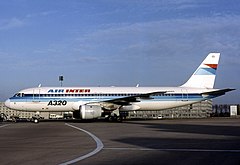Flight 148, commanded by 42-year-old Captain Christian Hecquet, with 8,800 flight hours including 162 flight hours on A320, and 37-year-old First Officer Joël Cherubin, with 3,600 flight hours including 61 hours on A320.[3] departed Lyon-Satolas (now called Lyon-Saint-Exupéry Airport) at 17:20 UTC. Both pilots were relatively new to the A320 with a combined total of only 300 hours in the aircraft,[4] but both were familiar with Strasbourg Airport as both had flown into the airport many times.
As the flight neared Strasbourg Airport, they informed ATC of their desire to follow the ILS approach for Runway 23 until the airport was in sight, followed by a visual approach onto Runway 05. This type of approach onto Runway 05 was common at Strasbourg Airport;[4] being near mountains and high terrain, Runway 05 was not equipped with ILS since the high terrain would interfere with the glide slope signal transmitted by the ILS. ATC denied the pilots approach request, saying there would be a significant delay because of conflict with several aircraft departing on Runway 05 and instead offered vectors for the VOR/DME approach for Runway 05, which the pilots accepted. The flight was cleared to descend to 5,000ft and vectored to the ANDLO waypoint 11 nautical miles from the Strasbourg Airport VOR. ATC cleared the aircraft onto the final approach at 18:19 UTC as it passed ANDLO, where the pilots turned left onto the runway heading of 050 degrees and continued to descend as per the approach chart.
At 18:20:33 UTC, Flight 148 crashed into the slopes of Mont Sainte-Odile at 2,620ft, 10.5 nautical miles from the airport. The search and rescue operation commenced at 18:40. 3 helicopters, 24 motorcycles, and 950 people from the Police Nationale, National Gendarmerie, Sécurité Civile, as well as 24 amateur radio operators participated in the search and rescue operation.[4] Although almost 1000 people were involved in the search effort, it was criticised for being unprepared and disorganised as it was not clear which of the 3 agencies would lead the search, hampering the search and rescue effort. The crash site was not discovered until 22:35 UTC (4 hours and 15 minutes later) when a group of journalists were led to the wreckage by a surviving passenger, Nicolas Skourias. The first rescuers, a group of Gendarmes, arrived at 22:49 after being led to the wreckage by the same survivor and a journalist.
The Bureau of Enquiry and Analysis for Civil Aviation Safety (BEA) found that Flight 148 crashed because the pilots left the autopilot set in Vertical Speed Mode instead of Flight Path Angle Mode and then set "33" for "3.3° descent angle", resulting in a high descent rate of 3,300 ft (1,000 m) per minute into terrain.[1]
The pilots had no warning of the imminent impact because Air Inter had not equipped its aircraft with a ground proximity warning system (GPWS). It is speculated that this was because Air Inter—facing ferocious competition from France's TGV high-speed trains—may have encouraged its pilots to fly fast at low level (up to 350 kn [650 km/h; 400 mph] below 10,000 ft [3,000 m], while other airlines generally do not exceed 250 kn [460 km/h; 290 mph]), and GPWS systems gave too many nuisance warnings.[5]

